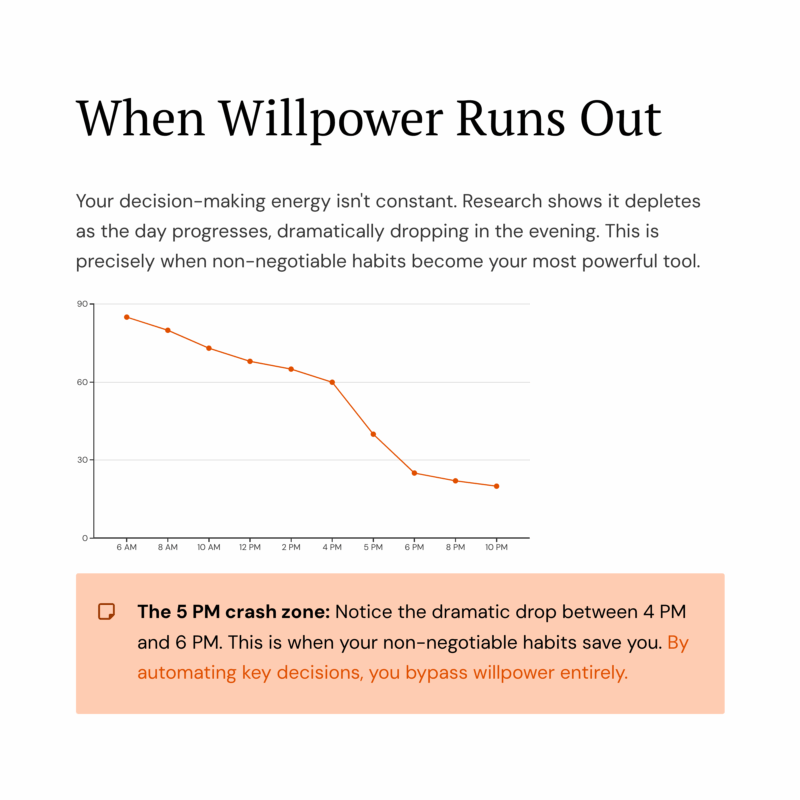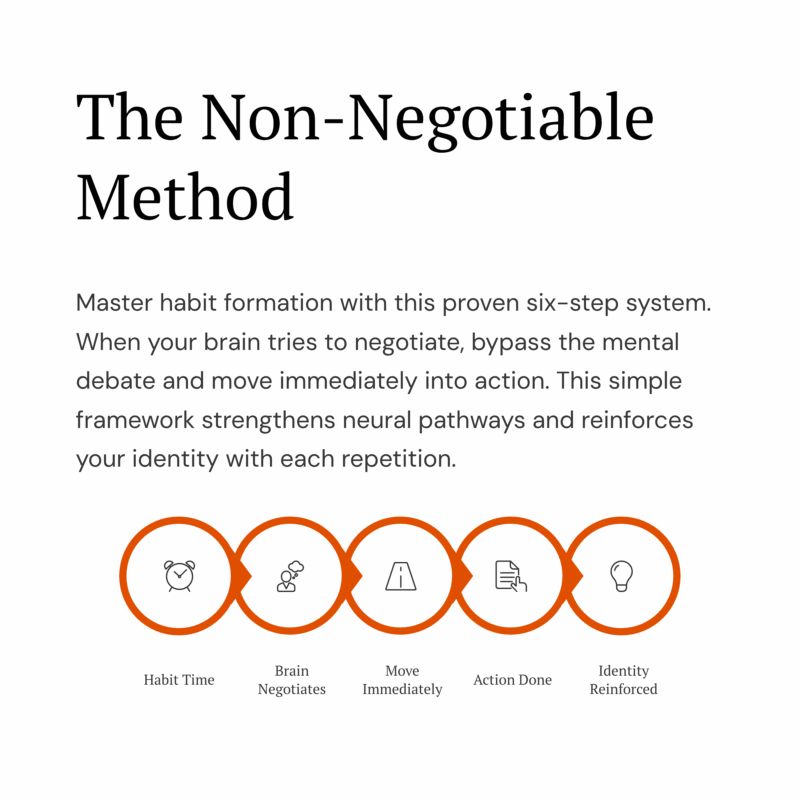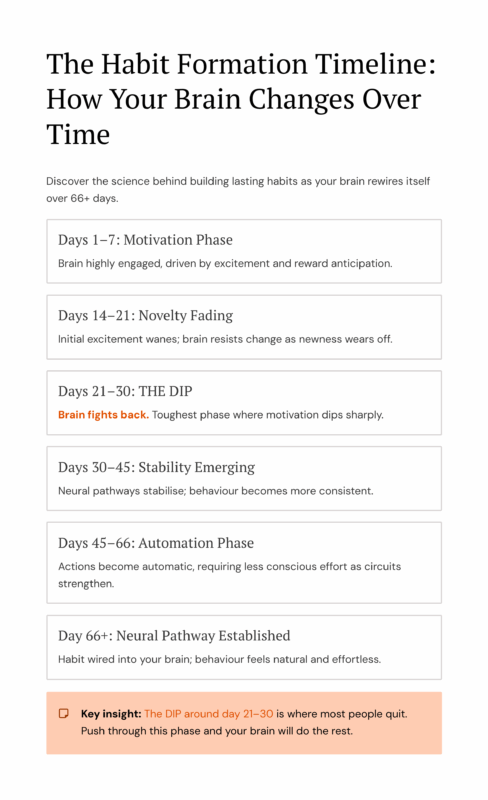Quick Summary: Motivation abandons you the moment things get hard. This post reveals why your brain sabotages your best intentions at 5 PM on a Tuesday, and the simple “non-negotiable” method that rewires your neural pathways so you show up even when you don’t feel like it. Reading time: 10 minutes.
Table of Contents
- The Motivation Trap (And Why You Keep Falling For It)
- Why Motivational Content Stops Working
- What Actually Works: The Non-Negotiable Method
- The Brain Rewiring That Changed My Life
- Your Transformation Starts With One Non-Negotiable
- Common Questions About Motivation & Discipline
- How Decision Fatigue Drives Self-Sabotage (And How to Beat It)
- The Bottom Line
- Take a Moment to Reflect
You Know This Pattern By Heart
You wake up fired up. Today’s the day. You’re hitting the gym, meal prepping, starting that project. You can feel it this time.
Then 5 PM hits.
Your brain whispers: “You’re tired. You had a long day. You deserve rest. Skip today, you’ll do it tomorrow.”
And just like that, motivation ghosts you. Again.
Here’s the direct answer: Motivation fails because it’s an emotion-dependent state that disappears when you face discomfort, fatigue, or stress. Your brain is wired to conserve energy and avoid pain, so it negotiates reasons to quit—typically around 5 PM when decision fatigue peaks. The fix isn’t stronger willpower, it’s removing negotiation entirely.
I learned this the hard way, and I’m about to show you exactly how to rewire those neural pathways so discipline becomes automatic.

Disclaimer: I’m not a therapist or neuroscientist — just someone who rebuilt their life the slow way. What I share here blends lived experience with credible research from behavioural science and the NHS. If you’re struggling with your health or mental health, please speak to your GP or a qualified professional.
Note: This approach works for most neurotypical brains. If you have ADHD or other neurodivergent conditions, some of these strategies may need adaptation—your brain’s wiring is different, and that’s not a flaw.
The Motivation Trap (And Why You Keep Falling For It)
Motivation hits like sugar — sweet for a moment, then gone when you need energy most.
It feels incredible when it hits:
- “I’ve got this!”
- “Just believe in yourself!”
- “This time will be different!”
But motivation is a fair-weather friend. It abandons you precisely when you need it most: when you’re exhausted, when old habits scream for attention, when your brain builds a bulletproof case for why you should quit.
The brutal truth? You’ll never feel like doing the hard thing when it matters. And if you’re waiting for motivation to save you, you’ll wait forever.
Why Your Brain Sabotages You at 5 PM
Your brain isn’t trying to ruin your life—it’s trying to protect you.
For 30 years (or however long you’ve been alive), you’ve trained it with specific patterns:
- 5 PM = rest time
- Tired = stop moving
- Uncomfortable = avoid at all costs
These are neural highways—well-worn pathways your brain defaults to because they’re efficient. Changing them requires more than enthusiasm. It requires strategic rewiring.
Here’s what that looks like in real time:
My 20-year-old daughter burst through the door with fire in her eyes. “I’m joining the gym! I’m going 5-6 times a week! I’ve got this!”
I gently suggested starting with 3 consistent days a week. But she was riding the motivation wave hard.
Four months later? She stopped completely.
When I asked why, her answer revealed everything: “I lost my motivation.”
That’s the pattern. That’s the trap. And if you don’t understand what’s really happening in your brain, you’ll repeat it forever.
Even on those grey London evenings when it’s raining sideways and your brain says “not today,” that’s when the non-negotiable rule matters most.
Your Journey To Everyday Mastery Starts Here
If you’ve done this dance too, you’re not broken, your brain is efficient. So let’s give it a better route.
According to an NHS 2024 mental-health report, consistent daily movement improves emotional regulation more effectively than relying on motivation alone.
(link: https://www.nhs.uk/mental-health/self-help/guides-tools-and-activities/)
Why Motivational Content Stops Working
Maybe you’ve tried the motivation route too. The books, the videos, the fire-you-up speakers promising breakthrough after breakthrough.
It works brilliantly—for about two weeks.
I consumed it all. Tony Robbins, every motivational speaker I could find. I’d get high off their energy, feel unstoppable, then crash the moment real life kicked in.
Here’s what they don’t tell you: Motivational content is repackaged wisdom wrapped in hype. Nothing wrong with that—it helps millions of people get started. But motivation is a feeling, and feelings are terrible at overriding 30 years of hardwired neural pathways.
When your lazy day arrives, when you overeat that one evening, when your old limiting beliefs whisper “see, you can’t change”—motivation does absolutely nothing. It’s not there. It abandoned you three days ago when things got boring.
You haven’t failed at motivation. Motivation failed you. It was never designed to rewire your brain—just to make you feel good about wanting to change.
The fix isn’t better motivation. It’s a completely different system.

What Actually Works: The Non-Negotiable Method
Quick take: Make actions automatic by cutting off your brain’s negotiation before it starts—no internal debate allowed.
Here’s the shift that changes everything: You don’t master yourself through motivation. You master yourself by making certain discussions non-negotiable.
The Real Conversations in Your Head
Let me get brutally honest about what goes through my mind on the hard days:
Brain: “I’m tired. I can’t work out today.”
Me: “Yes, you can. That’s what you do.”
Brain: “I had a long day. I deserve to skip today.”
Me: “We don’t just stop when it gets hard. Life is hard. Move it.”
If I literally can’t be arsed to walk, I stand up and move immediately. I do not allow my brain to build a case for why I shouldn’t. Because once it starts negotiating, it’s game over.
The thoughts are regular visitors:
- “I’m tired”
- “I had a long day”
- “I can skip today”
I acknowledge them, let them pass, and get back to work.
How to Hijack Your Brain’s Negotiation Tactics
Step 1: Don’t Think, Just Move
The moment you give your brain a chance to negotiate, you’ve lost. Your brain is designed to conserve energy and avoid discomfort. It will build an airtight case for quitting.
Your job? Cut the negotiation off before it starts.
When it’s time to exercise/work/create, move your body immediately. Stand up. Put on shoes. Walk out the door. No internal debate allowed.
Step 2: Acknowledge, Don’t Engage
Those tired, resistant thoughts will come. You can’t stop them—they’re hardwired.
But here’s what changed everything for me: You are not your thoughts.
Early in my journey, I ate a very large piece of cake and immediately heard my old voice: “It’s okay, I’m fat anyway.”
I stopped that thought dead in its tracks. That was an old belief trying to sabotage my new identity.

This Was My Mr Critic Moment
“It’s okay, I’m fat anyway.”
That voice tried to keep me stuck. But I caught it, named it, and kept moving.
What does YOUR Mr Critic Say in moments like this?
As neuroscientist Dr. Andrew Huberman explains, “We can direct our own neural changes through focused attention and repeated behaviour.” Your thoughts are just neural patterns, not permanent truths. I now call that voice my “Mr Critic” and let him go chat his shit elsewhere because I’m not listening. Before discovering this, that guy would get stuck in my head and I’d throw in the towel because “it’s all pointless.”
The truth: Feelings are real and can be powerful, but you don’t have to act on them.
Step 3: Build Identity, Not Goals
Stop saying: “I want to exercise.”
Start saying: “I’m someone who exercises.”
The identity shift rewires everything. You’re no longer trying to do something foreign—you’re being who you are.
As James Clear explains in Atomic Habits, when your brain says “I don’t feel like it,” your identity responds: “Doesn’t matter. This is what I do.”
Step 4: Expect the Dip (And Plan For It)
Motivation will leave you. The honeymoon phase ends. That’s not failure—that’s biology.
The difference between people who transform and people who quit? They expect the dip and have systems in place.
My daughter tried 5-6 gym visits per week powered by motivation. I suggested 3 consistent days powered by habit.
Guess who’s still exercising?
Step 5: Start Small, Stay Consistent
You don’t need massive action. You need consistent action.
- 3 gym days beats 6 inconsistent days
- 10-minute walks beat sporadic marathon sessions
- One daily habit beats 10 abandoned resolutions
Small + consistent = neural rewiring. Big + sporadic = burnout.
Want to track your own progress? Try the free Non-Negotiable Habit Tracker.”

💬 If you’re nodding along thinking “this is me at 5 PM,” bookmark this section — it’s your pattern interrupt.
The Brain Rewiring That Changed My Life
Quick take: Your brain physically changes through repeated behaviour—neuroplasticity allows you to replace 30-year-old patterns with new ones in 66+ days.
Here’s what nobody tells you about transformation: Every habit, every thought pattern in your brain can be changed if you start rewiring those neurons.
You do this by building habits over time and gradually building new beliefs. Recent neuroscience research in Trends in Cognitive Sciences confirms that habit formation involves structural changes in the brain’s corticostriatal pathways, with the dorsolateral striatum gradually taking over control of repeated behaviours from the prefrontal cortex.
People think they can’t change because “it doesn’t come naturally to them.” But that’s just an identity they’re holding onto.
The EastEnders Experiment
My old brain had a non-negotiable rule: “5 PM—that’s it, I’m done for the day. Time to watch EastEnders and Coronation Street.”
I was wasting hours every week on storylines that were completely irrelevant to my actual life.
One day, I decided those hours were too precious to waste.
What happened next revealed everything about how brains actually change:
A few weeks in, my brain would panic: “We need to watch EastEnders! What’s happening with the storylines?”
My response: “It’s irrelevant to my life. I don’t have enough life tokens to waste on this crap.”
Now instead of collapsing at 5 PM, my husband and I explore local forests until 8 PM. Then I read or listen to podcasts while he watches his films.
The shift didn’t happen because I felt motivated. It happened because I made it non-negotiable and gave my brain time to rewire.
Do I occasionally miss the soaps? Yes. My old brain still pipes up sometimes: “Wonder what’s happening on EastEnders…” But that thought passes. I acknowledge it, smile at how predictable my brain is, and carry on with my actual life.
When the Shift Actually Happens
I didn’t consciously shift from motivation to habits. It just happened over time. The more I stuck with small actions, the more my brain started saying:
- “Hey, it’s time to walk”
- “Hey, isn’t it Monday? That’s leg day”
The magic happened when I stopped thinking and started being. My brain went from fighting me to prompting me. That’s when you know the neural pathways have rewired—when the habit starts reminding you, instead of you forcing the habit.
Research from University College London suggests it takes an average of 66 days to form a new habit, though this varies widely by person and habit complexity. While not everyone agrees on the exact timeline, some habits form faster, others take longer—the principle remains: consistent repetition creates automatic prompts that feel effortless. You’ll know you’ve made it when your brain becomes your ally, not your adversary.
Your Transformation Starts With One Non-Negotiable
Quick take: Start with one small action, same time daily, no negotiation—let 66 days of consistency rewire your brain automatically.
Stop waiting for motivation to strike. It’s not coming, and if it does, it won’t stay.
Instead, do this:
- Choose ONE small action (10-minute walk, 5 pushups, reading 2 pages)
- Do it at the same time every day (consistency builds neural pathways)
- Make it non-negotiable (no internal debate allowed)
- Build the identity (“I’m someone who moves daily”)
- Let time and consistency do the heavy lifting (trust the process)
Remember: The goal isn’t to feel motivated. The goal is to become someone who shows up regardless of how they feel.
Because that person? That person transforms their entire life.
When your brain whispers “it’s too hot” or “do it later”, that’s exactly when you lean into action — because motivation that actually lasts comes from identity, not bursts of willpower.
The Permission to Break (Strategically)
One more truth motivation culture won’t tell you: It’s okay to take breaks.
I’m going on holiday in a couple of weeks. For 7 days, I’ll walk but won’t do other exercise. That’s good—my body benefits from rest.
But the moment I’m home, I carry on. Because if I break the cycle too long, those 30-year-old habits would take hold very quickly.
Planned breaks are strategic. Indefinite breaks are sabotage.
And if you do break the cycle too long? You haven’t failed, you’ve just hit pause. The non-negotiable method works just as well on day 1 as it does on day 201.
My mum started a walking routine and missed day 7. She told me she’d “double down” on day 8 to make up for it—walk twice as long because she’d skipped. I stopped her right there: “It’s not a punishable crime. Just go back to your normal walk tomorrow.”
That’s the shift. Missing a day isn’t failure requiring penance. It’s just a pause. No shame, no drama, no punishment walks. Just start again.
True rest fuels motivation that actually lasts, not just the short bursts that fade after a few days.
Your Emergency Restart Protocol
Life will derail you. Illness, grief, work chaos, family emergencies—it happens. Here’s how to come back without the shame spiral:
When you’ve been off track for a week or more:
- Don’t “catch up” – Start where you are, not where you “should” be. No double workouts, no punishment reps.
- Pick the smallest version – 5-minute walk instead of 30. Two pages instead of a chapter. The habit matters more than the intensity.
- First day back = identity day – You’re not doing it for results. You’re doing it to prove: “I’m still this person.”
- Expect it to feel hard again – The groove will return in 3-5 days. Your brain just needs to remember the pattern.
- One non-negotiable rule: No punishment – Remember my mum’s story. It’s not a crime that requires penance.
Bookmark this section. When life explodes and you need to restart, come back here. You haven’t failed. You’ve just hit pause.

📌 Bookmark this post — next time you feel unmotivated, come back and read just the “Non-Negotiable Method” section.
Common Questions About Motivation & Discipline
Why Does Motivation Fail So Quickly?
Motivation fails quickly because it depends on emotional states that fluctuate throughout the day. Decision fatigue peaks around 5 PM, depleting the mental energy needed to resist your brain’s default patterns. After 30+ years of established neural pathways, your brain defaults to comfort-seeking behaviours when willpower fades, which is why motivation typically lasts only 2-4 weeks.
How Do I Become Disciplined Without Motivation?
Become disciplined by using the non-negotiable method: eliminate internal negotiation by moving immediately when it’s action time, build identity-based habits (“I’m someone who exercises” not “I want to exercise”), and create consistent daily triggers that automate behaviour. As James Clear explains in Atomic Habits, discipline is built through neural rewiring over 66 days, not through willpower or motivation.
What’s the Difference Between Motivation and Discipline?
Motivation is an emotion-dependent state that requires you to feel like taking action. Discipline is an identity-based system that causes you to take action regardless of how you feel. Here’s the key difference:
| Aspect | Motivation | Discipline |
|---|---|---|
| Reliability | Disappears when tired | Present regardless of state |
| Sustainability | Lasts 2-4 weeks | Becomes automatic after 66 days |
| Trigger | Requires emotional high | Triggered by time/identity |
| Failure Point | 5 PM decision fatigue | Minimal—built into routine |
| Brain Response | Negotiates reasons to quit | No negotiation allowed |
Motivation abandons you during discomfort; discipline operates through automated neural pathways that bypass emotional negotiation entirely.
How Long Does It Take to Build a Habit?
Building a habit takes an average of 66 days according to University College London research by Phillippa Lally. Simple habits (like drinking water) automate faster (18-21 days), while complex habits (like daily exercise) can take 200+ days. The key is consistency, not intensity—small daily actions create stronger neural pathways than sporadic intense efforts.
Can You Really Rewire Your Brain?
Yes, through neuroplasticity—your brain’s ability to form new neural connections throughout life. Consistent repeated actions create new neural pathways while old pathways weaken from disuse. This process begins within days but requires 66+ days for full automation. The NHS explains that building healthier habits works precisely because your brain physically rewires itself through repeated behaviour patterns.
Why Do I Always Quit After a Few Weeks?
You quit after a few weeks because that’s when the “motivation honeymoon” ends and your 30+ years of established neural pathways fight back. Around day 21-30, your brain panics and creates intense negotiation (“I’m too tired,” “I deserve a break”). Most people cave to this negotiation. The solution is expecting this dip and having non-negotiable systems in place before it arrives.
How Decision Fatigue Drives Self-Sabotage (And How to Beat It)
Decision fatigue is why your best intentions crumble at 5 PM. Every decision you make throughout the day—what to eat, which task to tackle, whether to respond to that email—depletes your mental energy. By evening, your brain is exhausted and defaults to the easiest option: your old 30-year habits.
This isn’t weakness. It’s biology. Your prefrontal cortex (the decision-making part of your brain) runs out of fuel, and your basal ganglia (the autopilot system) takes over. That’s why you can resist the biscuit tin at 10 AM but demolish it at 8 PM.
The non-negotiable method beats decision fatigue by removing decisions entirely. When your workout time arrives, you don’t decide—you move. When your old brain says “let’s discuss this,” you’ve already got your shoes on.
Practical ways to reduce decision fatigue:
- Pre-decide everything habitual (same workout time, same walking route, same morning routine)
- Reduce daily decisions (meal prep, capsule wardrobe, automate bills)
- Schedule challenging habits for high-energy times (morning before decision fatigue kicks in)
- Create environmental cues (gym bag by the door, book on the pillow, walking shoes visible)
The goal isn’t more willpower—it’s fewer decisions.
Systems build structure, but meaning sustains it. The Alignment Habit explores how values-based habits turn consistency into meaningful progress you can actually feel day to day.
The Bottom Line
Your thoughts will try to negotiate. Don’t give them a platform. Just move.
Your motivation will abandon you at 5 PM on a Tuesday. Your habits won’t.
Stop chasing the feeling. Start building the identity.
Motivation fades, but reflection reinforces it — this simple Stoic loop shows how.
Ready to build unshakeable habits? Download our free Habit Stacker eBook and discover how to layer small actions into automatic routines that transform your life. Get your free copy here.
Take a Moment to Reflect

Journalling Prompt:
Where do you usually negotiate with yourself? (Is it at 5 PM? After a long day? When you’re tired? When you see the sofa?)
What would happen if you cut that negotiation off tomorrow? Write it down. Make it real.
Ready to build unshakeable habits instead of chasing motivation? Start with our collection of daily reminder designs that keep you focused on who you’re becoming, not how you’re feeling.
Browse our complete collection of daily reminder designs that keep you focused on who you’re becoming, not how you’re feeling.
Found this helpful? You can buy me a coffee to support more writing like this. Every cup helps me keep creating resources
Kel is the writer behind Everyday Mastery, where she shares the real, messy, and meaningful process of building habits, resilience, and self-belief from the ground up. Her writing blends ancient philosophy with modern science, always focused on small, practical steps that lead to lasting





